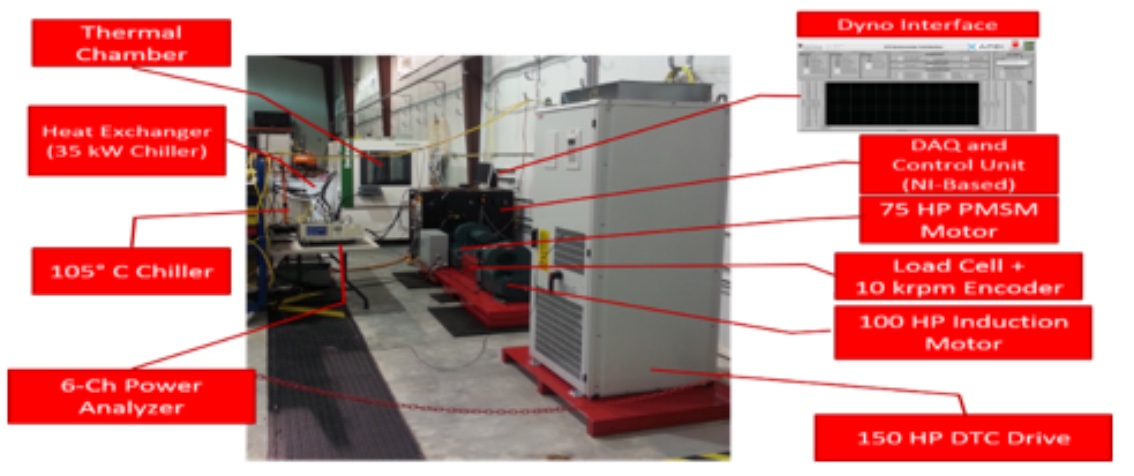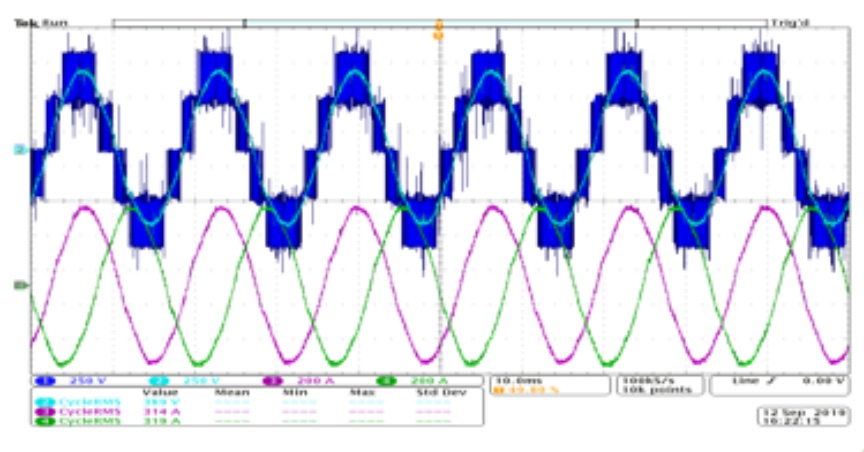Generation 2 Dynamometer Testbed 2 for On-Highway Automotive System Testing
Outcome/Accomplishment
The Center for Power Optimization of Electro-Thermal Systems (NSF POETS), a U.S. National Science Foundation (NSF)-funded Engineering Research Center (ERC) headquartered at the University of Illinois at Urbana-Champaign (UIUC), has developed the NSF POETS 100-horsepower (HP) Dynamometer Testbed 2 — a safe, robust, and cost-effective stationary platform for validating power conversion units for on-highway automotive system testing. The testbed features hardware-in-the-loop (HIL) capabilities to implement EPA and user-produced driving cycles to a given vehicle for “inverter under test” (IUT) evaluation under realistic test environments.
Impact/Benefits
: Dynamometers are used to measure factors such as force, torque, and power. They are predominantly used in the automotive and aerospace industries to better assess the operations of mechanical systems, including their performance, efficiency, and durability. The testbed developed at NSF POETS will be available for researchers, industry advisory board members, and external users to assess the performance of on-highway automotive systems under harsh environmental conditions. The testbed can also be leveraged as a teaching tool that combines software and hardware platforms for undergraduate and graduate education or as a showcase for K-12 campus tours, enabling the next generation of researchers in NSF POETS’ unique electrical-thermal co-design methodologies.
Explanation/Background
The dynamometer testbed consists of a thermal chamber, heat exchanger (with a 35-kilowatt (kW) chiller), 105 degree Celsius chiller, 6-channnel power analyzer, the Dyno interface, a nickel (NI)-based Data Acquisition (DAQ) and Control Unit, a 75 HP permanent magnet synchronous motor (PMSM) motor, a load cell + 10k revolutions per minute (krpm) encoder, a 100 HP induction motor, and a 150 HP direct torque control (DTC) drive. Harsh climate conditions can be emulated in the testbed using an environmental chamber and/or the Matlab/SimulinkTM-based vehicle modeling. This element is instrumental for unique electrical-thermal testing examples such as testing tire-to-surface interactions.
Examples of equipment testing cases to date with the dynamometer’s unique HIL capabilities include: “gen 1” and “gen 2” traction inverters, ARPA-E 250-kilowatt (kW) traction inverter, commercial traction inverters, and a propulsion drive system for a “more-electric-aircraft.”
Location
Urbana-Champaign, Illinoiswebsite
Start Year
Microelectronics and IT
Microelectronics, Sensing, and IT
Lead Institution
Core Partners
Fact Sheet
Outcome/Accomplishment
The Center for Power Optimization of Electro-Thermal Systems (NSF POETS), a U.S. National Science Foundation (NSF)-funded Engineering Research Center (ERC) headquartered at the University of Illinois at Urbana-Champaign (UIUC), has developed the NSF POETS 100-horsepower (HP) Dynamometer Testbed 2 — a safe, robust, and cost-effective stationary platform for validating power conversion units for on-highway automotive system testing. The testbed features hardware-in-the-loop (HIL) capabilities to implement EPA and user-produced driving cycles to a given vehicle for “inverter under test” (IUT) evaluation under realistic test environments.
Location
Urbana-Champaign, Illinoiswebsite
Start Year
Microelectronics and IT
Microelectronics, Sensing, and IT
Lead Institution
Core Partners
Fact Sheet
Impact/benefits
: Dynamometers are used to measure factors such as force, torque, and power. They are predominantly used in the automotive and aerospace industries to better assess the operations of mechanical systems, including their performance, efficiency, and durability. The testbed developed at NSF POETS will be available for researchers, industry advisory board members, and external users to assess the performance of on-highway automotive systems under harsh environmental conditions. The testbed can also be leveraged as a teaching tool that combines software and hardware platforms for undergraduate and graduate education or as a showcase for K-12 campus tours, enabling the next generation of researchers in NSF POETS’ unique electrical-thermal co-design methodologies.
Explanation/Background
The dynamometer testbed consists of a thermal chamber, heat exchanger (with a 35-kilowatt (kW) chiller), 105 degree Celsius chiller, 6-channnel power analyzer, the Dyno interface, a nickel (NI)-based Data Acquisition (DAQ) and Control Unit, a 75 HP permanent magnet synchronous motor (PMSM) motor, a load cell + 10k revolutions per minute (krpm) encoder, a 100 HP induction motor, and a 150 HP direct torque control (DTC) drive. Harsh climate conditions can be emulated in the testbed using an environmental chamber and/or the Matlab/SimulinkTM-based vehicle modeling. This element is instrumental for unique electrical-thermal testing examples such as testing tire-to-surface interactions.
Examples of equipment testing cases to date with the dynamometer’s unique HIL capabilities include: “gen 1” and “gen 2” traction inverters, ARPA-E 250-kilowatt (kW) traction inverter, commercial traction inverters, and a propulsion drive system for a “more-electric-aircraft.”


